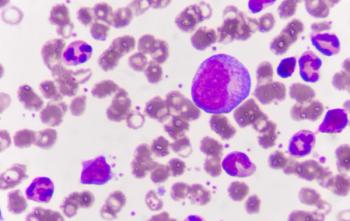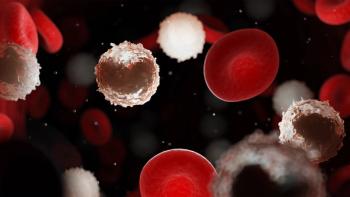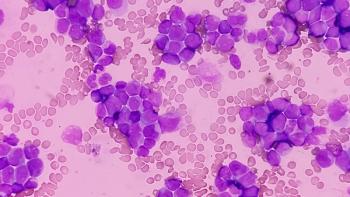
KN026/KN046 Combo Yields Durable Responses in HER2+ mBC
KN026 plus KN046 produced sustained responses and showed a manageable safety profile in pretreated patients with HER2-positive advanced breast cancer.
Combined treatment with the bispecific antibodies KN026 and KN046 resulted in durable responses and manageable toxicity in patients with previously treated HER2-positive advanced breast cancer, according to phase 2 trial data published in Clinical Cancer Research.
Among 36 evaluable patients, the confirmed objective response rate (ORR) was 47.2% (95% CI, 30.4%-64.5%), which included 2 complete responses (5.6%) and 15 partial responses (41.7%). An additional 33.3% of patients achieved stable disease (SD), including one individual with SD maintained for more than 24 weeks. The clinical benefit rate (CBR) was 50.0% (95% CI, 32.9%-67.1%). The median duration of response (DOR) was 15.2 months (95% CI, 4.1-not evaluable [NE]), and the median time to response was 1.5 months (95% CI, 1.4-2.8).
The median progression-free survival (PFS) was 5.6 months (95% CI, 4.1-13.8), with 6- and 12-month PFS rates of 46.6% (95% CI, 29.2%-62.3%) and 36.6% (95% CI, 20.6%-52.8%), respectively. At a median follow-up of 22.1 months, the median overall survival (OS) was 25.7 months (95% CI, 11.7-NE). The 12-month OS rate was 63.9% (95% CI, 46.1%-77.2%).
“The chemotherapy-free treatment of KN026 plus KN046 as second- or later-line therapy in patients with advanced HER2-positive breast cancer had a favorable efficacy with a comparative safety profile,” lead study author Jieqiong Liu, MD, of the Guangdong Provincial Key Laboratory of Malignant Tumor Epigenetics and Gene Regulation of the Breast Tumor Center at Sun Yat-sen Memorial Hospital of Sun Yat-sen University in Guangzhou, China, and colleagues wrote in the publication. “Further randomized controlled trials are required to confirm these findings.”
Phase 2 Trial Design
This open-label, multicenter, phase 2 trial was designed to assess the efficacy, safety, and tolerability of the combination of KN026, a HER2-targeted bispecific antibody, and KN046, a PD-L1/CTLA-4–directed bispecific antibody, in patients with HER2-positive solid tumors. Eligible patients were 18 to 75 years of age and had HER2-positive disease defined as HER2 immunohistochemistry (IHC) 3+ or HER2 IHC 2+ with gene amplification confirmed by in situ hybridization or next-generation sequencing. All participants had experienced disease progression following at least 1 prior HER2-targeted therapy in the advanced setting or within 12 months after completing neoadjuvant or adjuvant chemotherapy.
Additional inclusion criteria included ECOG performance status of 0 or 1 and measurable disease per RECIST 1.1 criteria. Patients were excluded if they had untreated active brain or leptomeningeal metastases, significant autoimmune disease, active infections, or prior exposure to systemic immunostimulatory agents within four weeks of enrollment. Treated and stable brain metastases were permitted.
Enrolled participants received KN026 at 30 mg/kg every 3 weeks following a loading dose on day 8 of cycle 1, and KN046 was given at 5 mg/kg every 3 weeks. Treatment continued until disease progression, unacceptable toxicity, or withdrawal of consent. Although dose delays for adverse effects (AEs) were allowed, dose reductions were not permitted.
Subgroup Analysis Findings
Subgroup analyses revealed a confirmed ORR of 66.7% in patients without liver metastases (n = 21) and 61.5% in those who had received 1 to 2 prior lines of therapy in the advanced setting (n = 13). Among the 3 patients with brain metastases, one achieved a PR lasting 35.9 weeks, another maintained SD for 18.4 weeks, and one experienced disease progression after 2 treatment cycles.
Exploratory subgroup analyses examined the association of PD-L1 expression and stromal tumor-infiltrating lymphocytes (TILs) with clinical outcomes. Among the 26 patients evaluable for PD-L1 status, no significant association was observed between PD-L1 combined positive score (CPS) and ORR (CPS ≥1, 75%; CPS <1, 60%; P = 0.968) or median PFS (18.4 vs 16.0 months; P = 0.482). In the TILs analysis (n = 18), patients with stromal TIL levels of at least 10% demonstrated numerically higher ORR (54.5% vs 14.3%; P = 0.550) and longer median PFS (13.8 vs 3.5 months; P = 0.216) compared with those with TIL levels of less than 10%, although the differences were not statistically significant.
Safety Findings
Among the 36 patients treated, the median duration of therapy was 24.2 weeks for KN026 (range, 6.0-104.9) and 23.9 weeks for KN046 (range, 5.9-104.7). Treatment-related AEs (TRAEs) occurred in 94.4% of patients, with the most frequent being infusion-related reactions (44.4%), elevated aspartate aminotransferase levels (36.1%), elevated alanine aminotransferase levels (30.6%), and diarrhea (30.6%). Grade 3 or 4 TRAEs occurred in 27.8% of patients, with the most common including decreased ejection fraction and increased γ-glutamyl transferase levels (5.6% each). No TRAEs led to death.
Four patients (11.1%) discontinued KN026 due to TRAEs, including peripheral edema, myocardial ischemia, infusion-related hypersensitivity reaction, and a multi-organ effect involving myocarditis and cardiac/respiratory complications. Seven patients (19.4%) discontinued KN046 due to TRAEs, including elevated phosphocreatine kinase levels, adrenal insufficiency, peripheral ischemia, immune-mediated pneumonitis, diabetic ketoacidosis, and a similar multi-organ complication. One patient (2.8%) experienced a serious AE related to KN026, and six patients (16.7%) experienced serious AEs related to KN046.
Sixteen patients (44.4%) experienced immune-related AEs (irAEs), with the most common being pruritus (22.2%), hypothyroidism (19.4%), hyperthyroidism (16.7%), and pulmonary inflammation (5.6%). Two patients experienced grade 3 irAEs, including adrenal insufficiency (n = 1) and a cluster of metabolic complications—diabetic neuropathy, angiopathy, and ketoacidosis (n = 1). No grade 4 or 5 irAEs occurred.
Anti-HER2–related AEs were reported in 88.9% of patients. Common AEs included pruritus (27.8%), infusion-related reactions (27.8%), diarrhea (27.8%), rash (22.2%), elevated AST levels (16.7%), elevated ALT levels (16.7%), weight loss (13.9%), lymphopenia (11.1%), neutropenia (11.1%), and hepatic dysfunction (11.1%). Grade 3 effects included ALT level increase (n = 1), lymphocyte and neutrophil count decreases (n = 1 each), γ-glutamyl transferase level elevation (n = 2), and upper respiratory tract infection (n = 1). No grade 4 or 5 anti-HER2–related AEs were observed.
Reference
Liu J, Song C, Yang Y, et al. Safety and efficacy of KN046 in combination with KN026 in patients with advanced HER2-positive breast cancer: a phase II trial. Clin Cancer Res. 2025;31(12):2379–2385. doi:10.1158/1078-0432.CCR-24-3888.
Newsletter
Knowledge is power. Don’t miss the most recent breakthroughs in cancer care.
















































































